The Colorado River as it flows around Horseshoe Bend on June 23, 2021, in Page. Severe drought is causing concern and heartache among those who rely on water from the Colorado River Basin. Photo by Justin Sullivan | Getty Images
The Gila River Indian Community has been a leader in Colorado River conservation efforts in Arizona, and their efforts are growing as funding from the Inflation Reduction Act will help the tribe launch new water conservation projects in October.
“Each one of these projects will allow us to use our water more efficiently on our farms, with annual savings in water of over 7,400 acre-feet per year,” Gila River Indian Community Gov. Stephen Roe Lewis said in a statement.
The Gila River Indian Community received funding from the Bureau of Reclamation for three separate critical water infrastructure projects totaling nearly $107 million.
GET THE MORNING HEADLINES DELIVERED TO YOUR INBOX
Lewis said the Gila River Indian Community is excited about the funding for the three major infrastructure improvements because they will have significant benefits — not only for the tribe, but for the entire region.
“We are the largest entitlement holder of Colorado River water delivered through the CAP canal; our savings can readily translate into major reductions in our use of Colorado River water, which will add to the one million acre-feet of our water that we have already left in Lake Mead for the benefit of the system,” he said.
The agreements with the Gila River Indian Community are the first long-term pacts to be signed, and according to the Bureau of Reclamation, they can potentially create system conservation of over 73,000 acre-feet within the next 10 years.
The money is split among the three projects: $64 million to replace and upgrade irrigation systems on Gila River Farms, $26 million to concrete line more than 7.5 miles of earthen canals in the Blackwater area and $17 million to construct a regulating reservoir to capture flows that are currently being spilled from the Santan Canal when too much water is accidentally ordered or delivered into the system.
Lewis said the projects are ready to go: Two will begin construction in early October, and the third will get underway in November.
“All the projects will be completed prior to the Post-2026 guidelines, which will undoubtedly hit the state of Arizona very hard,” Lewis added, referring to scheduled cuts to Arizona’s Colorado River allotment. “These savings will help us all weather those anticipated cuts and also put us in a position of ensuring we use every drop of our water most efficiently.”
The guidelines and strategies established to protect the stability and sustainability of the Colorado River, which supplies more than one-third of the Phoenix area’s water, will expire at the end of 2026.
The Colorado River is experiencing the longest and worst drought on record, driven by hotter temperatures due to climate change.
The Colorado River Basin provides water for more than 40 million people and fuels hydropower resources in seven U.S. states. It is a crucial resource for 30 tribal nations, as well as two states in Mexico.
U.S. Rep. Ruben Gallego, D-Phoenix, said Arizona’s tribes are critical partners in securing our water future and boasted that he helped secure the funding to support the Gila River Indian Community and conserve Colorado River water.
Lewis said that the Gila River Indian Community appreciates Gallego and the Arizona delegation’s role in ensuring drought and water conservation funding were included in the Bipartisan Infrastructure Law and the Inflation Reduction Act. The state’s Democratic members of Congress, as well as independent Sen. Kyrsten Sinema, all supported those measures; the Republicans all voted against them.
“We are proud to announce these agreements that will support the long-term health of the Colorado River System by shoring up (water levels),” Bureau of Reclamation Commissioner Camille Calimlim Touton said in a statement.
“The new agreements with the Gila River Indian Community are the beginning of our long-term investments that will improve the sustainability of our river for generations to come,” Touton said.
SUPPORT NEWS YOU TRUST.

